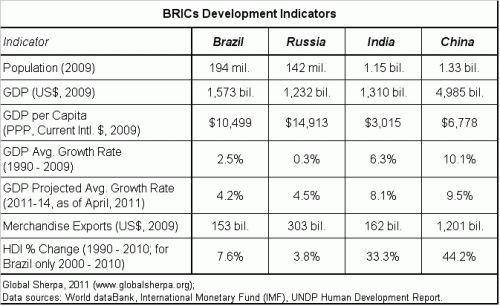The BRIC Economies
Post on: 16 Март, 2015 No Comment

Staff: Mentor
A lot of economic growth and investment opportunity is centered in the BRIC nations Brazil, Russia, India, China. But Russian and Chinese are difficult languages to learn. with Chinese there is the strange system of writing. Russian alphabet is comparatively easy but the language is highly inflected, you conjugate verbs, decline nouns, quite a bit worse than German, for example. Also many educated Russians know English so you can talk with them. Many in India also speak English. So I see a definite payoff to Portuguese.
Click to expand.
I recommend watch the interview with Jim O'Neill, Head of Global Economic Research, Goldman Sachs
CRGreathouse
In exchange rates, fine. PPP already has China as the second-largest economy in the world (not that G-S would care).
quadraphonics
Also, comparing the total size of the economies of countries with vastly different populations can be misleading. Even once China's economy is the same total size as America's, they'll still have 4 times as many mouths to feed. The upshot is that a much bigger chunk of their economy will be spent on prosaic things like food and clothing, leaving that much less for things like, say, defence or space exploration or R&D or investment or any of the other things that determine the relative influence of a given country.
It is true that a rising global per-capita GDP is going to continue to make things like oil and raw resources more expensive, but it need not raise the price of many of the things that we buy, such as manufactured goods, services, etc. Indeed, the development of China and India have proceeded exactly by *lowering* the global prices of such goods and services.
Even assuming that China's economy continues to grow at 9% per year, and America's at only 3.4%, it will still take almost 40 years for China's per-capita GDP to catch America's. Of course, it is extremely unlikely that China can sustain such high growth rates that long into the future. Their current growth strategies are predicated on the presence of external markets that dwarf their own, which will be less and less the case as they grow. Moreover, current Chinese development can be achieved simply by importing wholesale the more-productive technologies and practices that were developed elsewhere; no new innovation is required, nor has any significant innovation been evident. They simply ship subsistence farmers in from the countryside and put them to work in assembly-line plants that were developed and refined in the West over the past 150 years. Note that the majority of China's trade surplus is actually generated by foreign-owned companies, many of them American. Achieving per-capita GDP growth in the United States, on the other hand, requires the invention of new ways to improve productivity, either new technology or improved business practices. As China's per-capita GDP gets to be the same order of magnitude as that of the United States, they will have to shift to the latter type of innovation-led growth which, if they can even make the transition, will entail lower growth rates.
And that's without considering the radical demographic shifts that will occur in China in the next few decades, due to the one-child policy.
In short, projecting current trends decades into the future and getting worried about them is a foolish pursuit.














